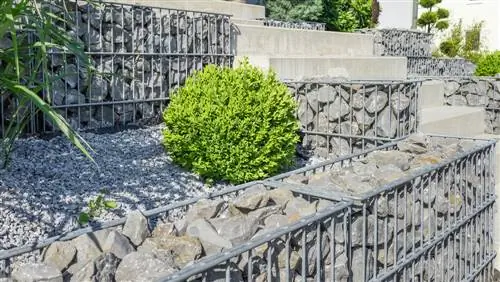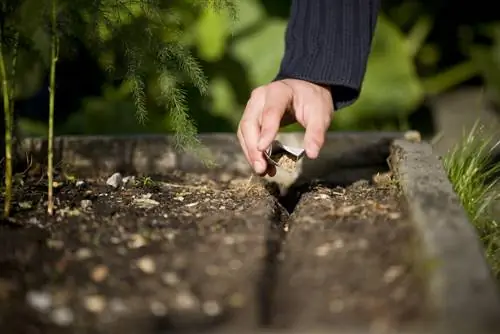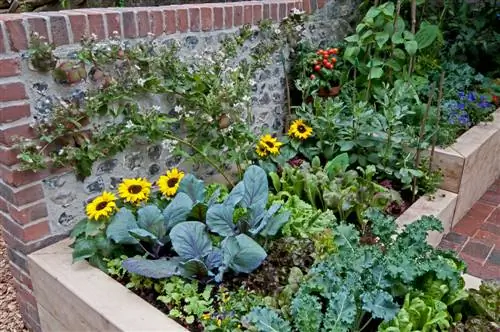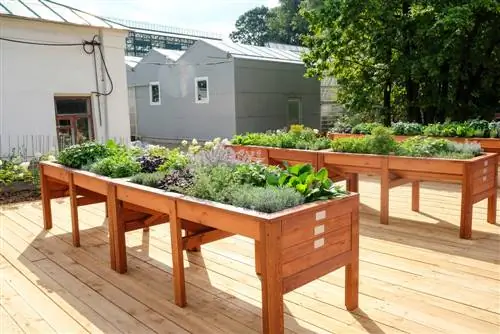- Author admin [email protected].
- Public 2023-12-16 16:46.
- Last modified 2025-01-23 11:21.
Raised beds do not necessarily have to be made of wooden boards or bricks. Instead, there are many creative options and materials that can be used to build beautiful raised beds. Gabions, for example, are ideal for building raised beds.
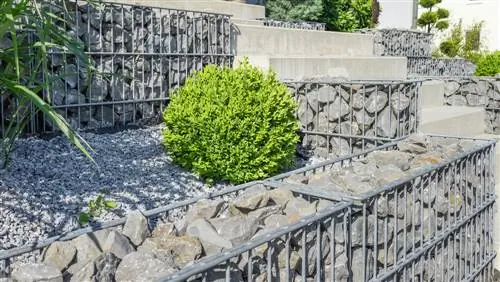
How to build a raised bed out of gabions?
You can build a raised bed made of gabions by choosing a suitable location, assembling and stabilizing wire mesh baskets, cladding the walls, filling the baskets with stones or other materials and then filling the raised bed itself with soil or a layer structure.
Gabions offer many possibilities
Gabions are lightweight wire mesh baskets that were originally used to fasten steep embankments and in hydraulic and landscaping. The grid boxes have now developed into a sought-after component in garden design. They can be used to build individual raised beds as well as entire terrace landscapes. They are usually filled with stones or round pebbles, but other materials such as pieces of wood, loose building rubble or old bricks are also possible. The size of the filling pieces depends on the mesh size of the wire mesh. With gabions you can build both square and round beds as well as those with a curved shape.
Assembling Gabions
You can get the wire mesh baskets as ready-made kits in any hardware store. Assembly is very simple: you simply connect two associated parts using the included spiral, which you screw into the outer edges of the parts in a clockwise direction. Gabions always consist of an inner and an outer basket, which is primarily used for stabilization. And this is how you build a raised bed out of gabions:
Select location and secure the surface
First of all, you need a suitable location for your gabion raised bed. Choose a sunny and sheltered spot where the ground should be firm, level and not riddled with thick tree roots. Remove the turf and carefully remove larger stones and weeds. Now dig a pit about ten centimeters deep and level the ground thoroughly. Lay out a rodent screen and, if necessary, a weed fleece.
Assemble and stabilize wire mesh
Now put the wire frames together as described. Stabilize the inner basket with steel anchors or other spacers. Finally, connect the inner and outer baskets in the same way. In the case of a rectangular raised bed, long stakes or sticks that you drive into the ground from the inside into the four corners of the bed provide additional stability.
Fill raised bed
Cover the walls of the inner basket with fleece or, if it's cheaper, with coconut mats. Covering it with foil is also possible, but basically not necessary - after all, the material doesn't need to be protected from moisture, just the filling of the raised bed from falling out. Now you can fill the wire baskets yourself: Field or other natural stones are suitable for this (round stones look particularly pretty), but also pebbles, larger pieces of wood (for example sawn pieces of trunks or thicker branches), chunks of glass, building rubble or old bricks. You can then fill the raised bed yourself, either with just soil or with the classic layering:
- Rabbit wire as protection against voles
- Coarsely chopped branches, brushwood and garden shredding as drainage
- Initially dug and turned over sod and topsoil
- Mixture of coarsely decomposed compost, straw and leaves
- Planting soil (e.g. mixture of topsoil and fine compost)
Make sure that the individual layers are not too thick - they compost more easily if you spread them loosely and thinly in the raised bed.
Fill gabions with soil
By the way, you don't have to fill the gabions with stones or similar - instead, simply fill them with soil and thus gain additional planting space, which can be used wonderfully for herbs etc. To prevent the substrate from falling out, you can cover the outside of the side parts with reed mats, for example. Not only does it look visually appealing, but it is also quite cheap to purchase. You can get reed mats as individually cut-to-measure pieces (€47.00 on Amazon) in many hardware stores. Small wild bees also like to nest in the reeds and find a suitable habitat here.
Tip
Instead of gabions, (old) wire baskets can also be used as mini raised beds. To prevent the substrate from falling out, simply cover the baskets with coconut mats and/or thatch mats.

